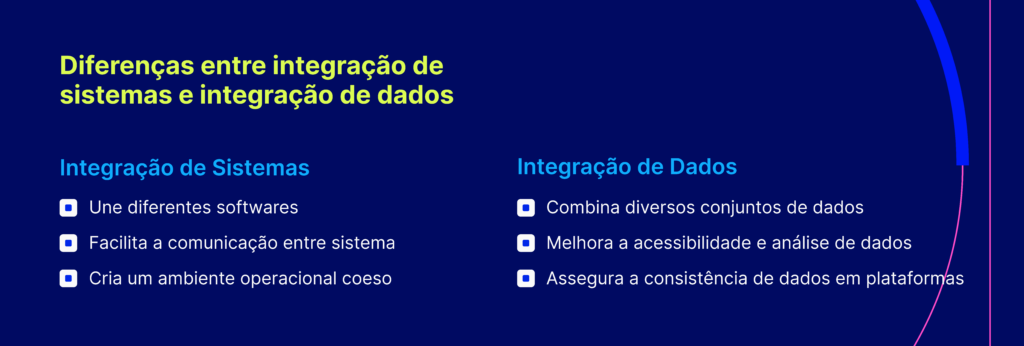The continuous advancement of technology and the increase in the complexity of information systems means that organizations face the challenge of managing multiple digital tools at the same time.
After all, as a company grows, it is natural for processes to become increasingly bureaucratic and complex, and as time passes, manual work to update information and systems becomes practically unfeasible.
This implies the need to create a cohesive ecosystem , in which sales, inventory, finance and human resources systems, for example, can share data and information efficiently.
This happens through what we call systems integration , an essential strategy for companies seeking to optimize processes and improve communication between different technological platforms. It consists of connecting different systems and software to cooperate, functioning as if they were one.
The increase in public and private investments in systems integration solutions to improve their Information Technology (IT) infrastructure drives the growth of this market around the world.
According to research released by Grand View Research global systems interaction market is expected to grow at a compound annual rate (CAGR) of 13.8% from 2023 to 2030.
benefits strategy include improvements in operational efficiency , reduced errors due to manual data entry, and the ability to provide a unified, up-to-date view of the business to make more informed decisions.
In this article, we will understand in detail what systems integration is, its types, the benefits it brings to the different areas of the company and its role in digital transformation.
What is systems integration?
Systems integration is a technology strategy through which companies optimize their internal processes. It favors the centralization of information , which contributes to an improved experience for both customers and employees.
This method allows different information systems to communicate efficiently and in real time, sharing data and resources.
Systems integration is important because each software is programmed with a different coding, and it acts as an intermediary that translates the data from each software behind the scenes. This ensures that all components work together in harmony to preserve productivity.
The information exchanges include customer data, orders, accounts payable or receivable information, etc., making it possible, for example, to integrate all systems , from a CRM with the ERP, to the e-commerce platform with the tax system. As a result, areas of the company become more connected.
How did systems integration come about?
Systems integration has roots in the continuous evolution of information technology and the growing need for organizations to make their systems more interconnected and efficient.
Initially, in the 1960s and 1970s, when mainframes were prevalent, integration involved connecting these centralized systems. With the adoption of distributed systems in the 1980s and 1990s, the challenge of integration increased, leading to the emergence of middleware to facilitate communication between different platforms.
The development of standards such as XML and SOAP in the 1990s, along with the rise of web services and SOA in the 2000s, introduced a more modular and flexible approach to integration.
Historically, as organizations began to incorporate various systems to manage their operations – from sales and inventory to finance and human resources – it became necessary for these systems to be able to communicate with each other in an automated way.
Currently, cloud computing drives solutions such as iPaaS (Integration Platform as a Service), providing tools hosted in the cloud for agile and scalable integration , meeting the complex demands of modern organizations.
This not only improved operational efficiency but also optimized decision making, as integration provides a unified view of business activities based on concrete information.
What is the difference between systems integration and data integration?
It is very common to confuse systems integration with data integration. Both are fundamental to improving operational efficiency in modern companies, but they do not refer to the same process .
Systems integration focuses on connecting software systems , allowing them to work together. Its goal is to create a collaborative environment where systems can communicate and operate as a cohesive unit.
This facilitates business processes by providing a unified view of how the company operates. In practice, systems integration may involve data sharing, but its scope is broader.
On the other hand, data integration specifically deals with handling and combining data from multiple sources . The process aims to unify information, normally within a database, so that it can be more easily accessed and analyzed. Data integration focuses on ensuring data quality and consistency is maintained across all platforms.
To make things easier, we list below the main differences between the two strategies:

Both processes are vital for digital transformation, but each has its specific role when it comes to managing organizations' information and technological resources.
How does systems integration occur?
In the past, systems integration used to be a complex task. Systems and applications from different providers required a point-to-point integration solution, relying on complex configurations and custom coding.
This format has proven to be inflexible and fragile, and requires constant maintenance, as each software update or process change can affect the entire integrated system.
Nowadays, the most robust integration solutions are already a reality. This enables new technologies such as cloud, Big Data and IoT to quickly communicate with each other and with current systems.
A good integration platform as a service generates the main internal gain of centralized management of all integrations between software , with real-time data processing, mitigating time spent on rework, data loss and system instabilities.
The methods for this integration to occur vary, but generally involve the use of APIs (Application Programming Interface) or middleware , software that acts as an intermediate layer between different applications, systems or components, facilitating the workflow between platforms.
System integrations can occur in two ways: unidirectional and bidirectional. Below, understand more about each of them.
Unidirectional
In unidirectional systems integration, information flows in a single direction, that is, from a source system to a target system . In short, it consists of one system sending information to another but not receiving anything from it.
For example, sales information can be sent from the point of sale to the inventory management system.
This approach is simple and reduces the complexity of the operation, but may not be sufficient for processes that require two-way communication.
Thus, the main advantages of unidirectional integration are implementation complexity reduced risks of data conflicts . The main disadvantage concerns precisely its limitation: it is only recommended in scenarios without the need to return information.
Bidirectional
In the opposite direction, bidirectional integration allows data to move both ways between integrated systems . This exchange can happen synchronously or asynchronously through APIs or middleware solutions, creating an ecosystem of applications that both receive and transmit information.
This happens, for example, in a business environment where there is a need to integrate a customer management system (CRM) with a marketing automation system.
This bidirectional integration allows for a continuous exchange of data between the two systems, ensuring that relevant information is always up to date on both platforms.
Two-way systems integration has two advantages , which are real-time (or close to it) updated synchronization and greater data consistency and integrity. On the other hand, its main disadvantage is that it is more complex in its implementation, which requires greater management needs.
What types of systems integration exist?
There are several ways to integrate systems, such as exchanging electronic data, using shared databases, implementing APIs, as well as horizontal and vertical integration models.
Each method has its particularities, advantages and disadvantages, which highlights the importance of knowing the specific needs to choose the most appropriate solution.
Systems integration types have evolved to facilitate communication and data sharing between different technology platforms. They are essential for companies seeking efficiency, scalability and information security.
Currently, there are five most common types of system integration: via API, legacy system integration, via database, via big data and integration with cloud services.
Find out the details of each of them:
Via API
Integration via API (Application Programming Interface) facilitates communication between independent systems . API stands out for its flexibility and efficiency, allowing systems to share functionalities and data in real time.
Although there are several API subcategories, including public and private, they all aim to make this connection of systems . By establishing these interconnections using a common code language, systems can transmit data between them.
Legacy system integration
Legacy system integration refers to updating old systems , often creating bridges between outdated technologies and modern systems.
This approach is essential for organizations looking to innovate without completely replacing their existing infrastructure . In short, it allows the organization to connect legacy systems to newer systems;
Via database
Via database integration occurs when different systems access and modify information directly in a common database . It requires careful access management to ensure data integrity and security.
For it to work, you need to use data extraction software .
Via Big Data
Data integration via Big Data involves the integration of systems that process large volumes of data and require high processing capacity.
This type is essential in any Big Data , because it allows the integration of data from various sources and in different formats . This way, you get all the data combined into a single visualization to be used for reporting and analysis.
In this case, Big Data is essential for analyzing complex information and supporting strategic decisions based on data.
Integration with cloud services
Integration with cloud services offers scalability and flexibility, allowing systems to share resources and data across cloud-based platforms .
It connects various applications, systems and databases to be integrated into cloud services, allowing access by multiple devices on a network or connected to the internet.
Single Sign-On (SSO) solutions are commonly used in this type of integration to simplify user authentication across various services.
Each approach has its merits and the choice of which to use needs to be based on factors such as cost, efficiency and the organization's strategic objectives.
| Type of Integration | Main Advantage | Recommended Cases |
| Via API | Ease of communication between systems. | Fast and efficient integration between applications, microservices and web platforms. |
| Legacy System Integration | Preservation of investments in existing systems | Environments with essential legacy systems, allowing gradual modernization without the need for complete replacement |
| Via Database | Efficient transfer of large volumes of data | Integration between systems that share structured data, such as relational databases, to support ETL or replication operations |
| Via Big Data | Scalable processing and analysis of large volumes of data | Environments that handle large amounts of unstructured data, such as logistics, IoT, and advanced big data analytics |
| Cloud Services | Flexibility and scalability in virtualized environments | Companies that use cloud services, allowing the integration of applications, storage and distributed processing in cloud environments |
What are the benefits of systems integration for companies?
Adopting integrated systems offers a range of benefits, from increased efficiency to significant improvements in decision-making and productivity.
Furthermore, companies that adopt this strategy can expect not only a cost reduction , but also a wide range of other competitive advantages, such as:
Operational efficiency
Systems integration improves organizational processes, making them more agile and reducing the occurrence of errors. This translates into more efficient operations and a more rational use of available resources.
Being able to integrate systems can be fundamental in saving employees' time, since it reduces manual work, thus increasing productivity.
Improved decision making
With data from different centralized , the company gains the ability to analyze information transversally, resulting in more informed and strategic decisions .
Due to its ability to use precise and complex data in an automated way, it provides a 360° view of the organization. As a result, better and more accurate decisions will be made from them, which allows organizations to grow and reduce their operating costs.
cost reduction
Integrating systems can eliminate redundancies , which consequently optimizes resources. This leads to a significant reduction in operating expenses.
automatic workflows , ensuring better process efficiency and also drastically reducing error margins.
Increased productivity
Integrated systems automate repetitive tasks and allow employees to focus on higher value-added , thus boosting the organization's productivity.
Improved customer experience
Consistent, accessible information significantly improves customer service, resulting in faster, more accurate responses .
Real-time business monitoring
real-time monitoring of different areas of the company, enabling a quick response to any need for operational adjustment.
Collecting all data in a central system optimizes business analysis, ensuring the reliability of information and increasing its added value.
Improvement in internal communication
A unified platform facilitates communication between departments, promoting greater cooperation and shared understanding of business objectives.
A clear example is the connection between all of systems with its ERP , which now guarantees the administrator a more complete view of the business.
Centralized security management
With system integration, information security is managed centrally, reinforcing protection against external threats and reducing vulnerabilities.
Unified data management
Centralizing data promotes its consistency, quality and availability, making it more reliable for analysis and reporting.
Through systems integration, managers can manage the entire volume of information more easily and obtain insights for decision-making, even using a single interface, which optimizes time and contributes to their productivity.
Alternative to replacing the legacy system
Integrating modern systems offers an alternative to legacy systems that are often inefficient and expensive to maintain.
Integrating data from legacy systems with modern systems allows organizations to continue working with them and continue advancing digital transformation .
What is the step-by-step process for implementing systems integration in companies?
Implementing systems integration in a company requires a detailed plan that guides the organization through several critical steps. Each phase must be meticulously planned and executed to ensure a smooth and effective transition between different systems.
Maybe you're wondering how, after all, you can identify the signs that it's time to implement systems integration in your company?
Observing operational problems, inefficiencies and specific challenges in company processes often indicate the need to consider systems integration as a solution to improve overall business efficiency and effectiveness.
If you have identified that it is time for your company to implement systems integration, check out a suggested step-by-step guide on how to carry out this process below.
Planning
The first step to successful systems integration is strategic planning. Companies must define clear objectives and establish an initial focus to guide the process and evaluate success later.
This planning includes process optimization, which identifies the company's needs and how integration can meet these requirements.
Development
During development, the tools and approaches that will be used in the integration are selected.
This step involves choosing appropriate technologies and designing an integration architecture that is robust and scalable. It is also essential to ensure compatibility between the systems that will be unified.
Tests
In the testing phase, integrated systems are rigorously tested to ensure they function as expected. Performance and security tests are crucial to verify the resilience of the integrated system.
Companies should test all possible scenarios to identify and correct flaws before implementation.
Implementation
This is the stage of putting the integrated solution into operation . It is crucial that there is a smooth transition without interrupting business activities. The company must be ready to resolve unforeseen events that may arise during this stage.
Improvements
After implementation, the continuous process of improvements begins. Systems integration is a constant effort that requires regular updates and adjustments to maintain the efficiency and relevance of the solutions adopted.
Feedback and continuous monitoring are essential to identify opportunities for optimization and evolution of the integrated system.
Each step is essential to ensure that systems integration is implemented effectively, promoting cohesive data management and enhancing organizational performance.
Why is iPaaS the best way to integrate systems?
As we mentioned previously, iPaaS means “Integration Platform as a Service”, or “Integration Platform as a Service” , in Portuguese. This is a category of cloud services that offers tools and resources to facilitate the integration of different systems and applications within a company.
The goal of iPaaS is to enable organizations to efficiently and automatically connect systems that could otherwise only operate in isolation.
As it is a cloud solution, iPaaS generally has a reduced cost software licenses , which used to be the most common form of systems integration in the past.
In this sense, iPaaS emerges as a modern and efficient for systems integration, offering significant advantages in terms of ease of use, speed of implementation, scalability, connectivity, simplified maintenance, cost-benefit and security.
It is important to highlight that, in practice, systems integration can be a challenge if it is carried out in an obsolete way, without the support of an integration platform . Integration projects that go wrong can have far-reaching consequences, even resulting in connections that break the IT fabric.
We detail below the main advantages of iPaaS as a form of systems integration:
ease of use
iPaaS is recognized for its intuitive and user-friendly interface , making system integration an accessible task even for those without advanced technical knowledge.
With visual and drag-and-drop tools, users can create integration flows without the need for extensive coding. This streamlined approach democratizes the onboarding process, allowing multidisciplinary teams to collaborate effectively.
Fast implementation
One of the most striking features of iPaaS is its ability for agile implementation. By eliminating the need for extensive development and manual coding, organizations can significantly reduce the time required to put integration solutions into practice.
iPaaS implementation speed is crucial to quickly adapt to changing business requirements and maintain a competitive advantage.
Scalability
iPaaS is designed to scale as the organization's needs grow. The flexibility offered allows companies to scale their integrations efficiently, dealing with growing volumes of data and more complex demands.
This inherent scalability ensures that the integration solution continues to be effective regardless of company size or expansion.
Pre-built connectivity
One of the great advantages of iPaaS is the presence of pre-built connectors for a wide variety of applications and systems.
This means organizations can save time and resources by using connectors that have already been developed and tested for specific integrations.
The extensive library of connectors available in iPaaS simplifies the integration process, allowing companies to focus on more strategic goals.
Simplified maintenance
Ongoing maintenance of integrations is optimized with iPaaS. Automatic updates, proactive monitoring and troubleshooting simplify daily operations.
Cost benefit
iPaaS stands out for its cost-benefit model, providing organizations with a flexible and efficient financial approach. With pay-per-use , companies avoid significant upfront investments by only paying for the resources consumed.
Additionally, by moving to cloud-based iPaaS, costs associated with physical infrastructure are eliminated, providing substantial savings.
Automating integration tasks also contributes to operational efficiency , optimizing human resources and providing tangible financial benefits.
Safety
Security is a core priority in iPaaS, ensuring comprehensive protection for data and operations.
The implementation of advanced protocols , such as strong encryption for data at rest and in transit, ensures the confidentiality and integrity of information.
Granular access controls allow organizations to define who has access to what data, minimizing the risks of unauthorized access. Additionally, iPaaS adheres to strict security standards, such as ISO 27001 certification , ensuring compliance with industry regulations and standards.
This robust, security-focused approach instills confidence in the integrity of the integration environment, making iPaaS a trusted choice for companies concerned about data protection.
Future trends in systems integration
The constant evolution of information technology continues to shape the systems integration landscape, with several trends that promise to transform the way organizations interconnect and operate their systems in the future.
One such trend is the growing adoption of microservices architectures , which disaggregate monolithic applications into smaller components, making them easier to maintain, scale, and integrate.
The cloud will continue to play a central role , with the emergence of system integration solutions entirely based on this technology, such as Integration Platforms as a Service (iPaaS).
Artificial intelligence ( AI) and other emerging technologies appear as significant drivers , promoting smarter and more autonomous integrations. The ability of systems to self-adjust, learn from usage patterns and anticipate integration needs will be increasingly valued, providing operational efficiency and real-time adaptability.
Artificial Intelligence (AI)
AI has emerged as a catalyst in systems integration, offering advanced automation and intelligent insights. It is the driving force behind many advances in systems integration.
Its application promotes process automation and agile decision-making, with systems that learn and adapt automatically. AI-powered integration systems can learn usage patterns, anticipate scalability needs, and dynamically adapt to changing business requirements.
The ability to process large volumes of data in real time drives operational efficiency and provides a smarter, more adaptive integration experience.
Companies that use AI in systems integration can expect improvements in operational efficiency and more personalized customer service.
Edge Computing
Edge Computing represents a change in traditional computing architecture. It is a data processing that occurs closer to the source of generation or consumption of this data, that is, at the “edge” of the network.
Instead of sending all data for processing to remote servers or the cloud, edge computing decentralizes some of this processing, allowing it to occur locally, close to the devices or systems that generate or consume the data.
In systems integration, Edge Computing reduces latency when processing data locally, improving the efficiency and speed of operations. This is particularly crucial in scenarios where real-time response is essential, such as in industrial and IoT applications.
The ability to integrate systems in a distributed way, taking advantage of local processing power, strengthens the resilience and agility of integration solutions. Businesses that integrate Edge Computing can better manage large volumes of data and accelerate insights .
IoT Devices
The Internet of Things (IoT) refers to an interconnected system of physical devices, vehicles, appliances and other objects embedded with sensors, software and network connectivity, allowing them to collect and exchange data with each other.
The essence of IoT is the ability for these “smart” objects to collect and share information about their environment and interact with each other , often without the need for direct human intervention.
In the context of systems integration, Internet of Things (IoT) devices are fundamental for collecting data in a variety of contexts. The integration of these devices facilitates real-time monitoring and control of operations.
It introduces a multitude of new data points and connected devices. Efficient integration of these heterogeneous devices is crucial to realizing the full potential of IoT. Additionally, collecting and analyzing data from sensors and IoT devices provides valuable insights to optimize operations and drive data-driven decision-making.
Systems integrated with IoT can offer a 360º view of business performance, enabling continuous optimizations and more efficient asset management.
The role of systems integration in digital transformation
Digital transformation represents a fundamental restructuring in companies' operations, strategies and business models, driven by the use of digital technologies. In this context, systems integration appears to be an essential pillar.
It enables different digital platforms and tools to communicate efficiently, facilitating process automation and data-based decision making.
Systems integration makes it easier for companies to adapt
In turn, integrated systems provide a consolidated view of the business, allowing quick and assertive actions. This speed and precision increase the competitiveness of organizations in the market.
Horizontal and vertical systems integration is a practical example of this application. Horizontal integration refers to communication between systems at the same hierarchical level, while vertical integration focuses on communication between systems at different levels.
Within the scope of Industry 4.0, this strategic integration is crucial for the application of high technology in manufacturing , directly impacting operational efficiency.
The approach to systems integration must be designed to reflect the objectives of digital transformation, always focusing on increasing efficiency , continuous improvement and meeting market demands.
With systems communicating harmoniously, companies become more flexible, intelligent and ready for the future.
How to ensure the best systems integration for your company?
To ensure the best integration of systems in a company, you must start with strategic planning . It is essential to define clear objectives.
For example, these objectives may be to save time, improve the quality of processes or reduce costs. A careful analysis of the needs and challenges will guide the entire integration process.
First steps
- Set objectives: focus on measurable goals that reflect the company’s needs;
- Choose the appropriate technology: find suitable solutions that align with the company’s objectives;
- Choice of Technologies and Partners: items such as performance and scalability must be considered when choosing technology. It is also important to select partners, such as Skyone , that offer reliable integration platforms that are suitable for the size and complexity of the existing infrastructure.
Implementation and Training
When technology is implemented, adequate user training is necessary to ensure that staff can maximize the use of the new tools. This is essential to achieve the desired levels of efficiency and performance.
Maintenance and Monitoring
After implementation, a continuous monitoring and maintenance to ensure that the integrated systems maintain a high quality of performance.
Constant evaluation allows you to quickly identify which adjustments are necessary to ensure the stability and efficiency of integrated systems.
Integrate your systems simply with Skyone
In the systems integration journey, finding a technology partner that can offer a robust and at the same time simplified solution is essential. Skyone stands out as this ideal partner , bringing to the market an iPaaS solution that allows you to connect different systems and applications in an efficient , secure and scalable .
Even without in-depth technical knowledge, your team can create and manage integrations between systems in a visual and intuitive way. Through a user-friendly interface , you can drag and drop components to configure workflows, establish connections between applications and automate processes with ease.
Find out how our platform can simplify your integration routine!
Conclusion
systems integration strategies represent a critical aspect for the operational strengthening of companies. They enable an agile and reliable flow of information between different departments, contributing enormously to the long-term sustainability of the business.
Investing in this technology is a strategic move that often results in saving resources and time . A unified and well-structured system allows for more accurate data analysis, in addition to promoting process automation.
Take advantage and discover more about the benefits of iPaaS within the world of integrations!




